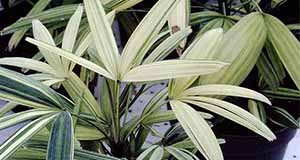Palms growing in Florida landscape or field nurseries are subject to a number of potentially serious nutrient deficiencies. This five-page document discusses the prevention and treatment of these deficiencies. Written by Timothy K. Broschat and published by the Environmental Horticulture Department.
http://edis.ifas.ufl.edu/ep261
Tag: Timothy K. Broschat
Rhapis excelsa: Lady Palm
Rhapsis excelsa, the lady palm, is an outstanding, small clustering palm for shady landscape or interiorscape use. This two page fact sheet gives a brief overview of the Lady Palm. Written by Timothy K. Broschat and published by the Environmental Horticulture Department.
http://edis.ifas.ufl.edu/fp501
10 Common Palms of the Tampa Bay Area
Palms often serve as key specimens in urban landscape designs. Despite this, their identity is often unknown to Florida’s new, seasonal, and even long-term residents. This ten-page fact sheet serves as a quick reference for some of the most common palms found in North and Central Florida and the Tampa Bay Area in particular. Written by Gitta Hasing, Andrew K. Koeser, Melissa H. Friedman, and Timothy K. Broschat and published by the Environmental Horticulture Department.
http://edis.ifas.ufl.edu/ep506
Metsulfuron-Methyl-Containing Herbicides Potentially Damaging Ornamentals when Applied to Turfgrass

Metsulfuron-methyl, also known as MSM, is an herbicide that is used to control broadleaf weeds and certain grass weeds. It provides effective control of some of the most problematic turfgrass weeds, such as wild garlic, Florida betony, dollar weed, and small Virginia buttonweed. Metsulfuron-methyl is absorbed by plant foliage, so if landscape plants come into contact with the spray or drift they can be injured. This four-page fact sheet describes the potential problems with metsulfuron herbicides, the areas most subsceptible to damage, how to diagnose injury, and how to reduce damage. Written by Chris Marble, Jason Smith, Timothy K. Broschat, Adam Black, Ed Gilman, and Celeste White and published by the School of Forest Resources and Conservation Department.
http://edis.ifas.ufl.edu/fr400
Adonidia merrillii: Christmas Palm

The Christmas palm (Adonidia merrillii) is a fast-growing palm that is well-suited for small sites, requires little maintenance, is relatively disease-free, and produces clusters of bright red fruit in winter, hence the common name Christmas palm. This 2-page fact sheet covers the Christmas palms biology, distribution and habitat, susceptibility to disease, and general care. Written by Timothy K. Broschat, and published by the UF Department of Environmental Horticulture, July 2015.
http://edis.ifas.ufl.edu/st658
Not All Landscape Palm Fertilizers Are Created Equal
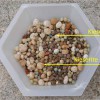 Palms are widely planted in Florida landscapes. Their bold leaf textures create a tropical or Mediterranean look that is highly desired by residents and tourists alike. But palms have very high nutritional requirements, and deficiencies of any element can result in conspicuous and unattractive symptoms on their large leaves. UF/IFAS research shows that the most effective fertilizer has 100% of the N, K, Mg, and B sources in slow-release or controlled-release form and that all of the Mn, Fe, Zn, and Cu sources should be water soluble. This 4-page fact sheet explains the reasons for this recommendation and how to ensure that you have a formulation that will be effective. Written by Timothy K. Broschat, and published by the UF Department of Environmental Horticulture, March 2015. (Photo Credit: T.K. Broschat)
Palms are widely planted in Florida landscapes. Their bold leaf textures create a tropical or Mediterranean look that is highly desired by residents and tourists alike. But palms have very high nutritional requirements, and deficiencies of any element can result in conspicuous and unattractive symptoms on their large leaves. UF/IFAS research shows that the most effective fertilizer has 100% of the N, K, Mg, and B sources in slow-release or controlled-release form and that all of the Mn, Fe, Zn, and Cu sources should be water soluble. This 4-page fact sheet explains the reasons for this recommendation and how to ensure that you have a formulation that will be effective. Written by Timothy K. Broschat, and published by the UF Department of Environmental Horticulture, March 2015. (Photo Credit: T.K. Broschat)
http://edis.ifas.ufl.edu/ep516
Butia odorata: Pindo Palm
 The pindo or jelly palm is a small, single-stemmed, feather-leaved palm widely grown in warmer parts of the US due to its unusual cold tolerance. It is considered hardy down to about 10°F (USDA zone 8A). The palm is slow-growing, eventually reaching 15 to 20 feet, making it suitable for planting under power lines. This 2-page fact sheet was written by Timothy K. Broschat, and published by the UF Department of Environmental Horticulture, February 2014.
The pindo or jelly palm is a small, single-stemmed, feather-leaved palm widely grown in warmer parts of the US due to its unusual cold tolerance. It is considered hardy down to about 10°F (USDA zone 8A). The palm is slow-growing, eventually reaching 15 to 20 feet, making it suitable for planting under power lines. This 2-page fact sheet was written by Timothy K. Broschat, and published by the UF Department of Environmental Horticulture, February 2014.
http://edis.ifas.ufl.edu/st105
Bismarckia nobilis: Bismarck Palm
 The Bismarck palm is a native of Madagascar that grows to a height of 30 to 60 feet with a spread of 12 to 16 feet. The massive 4-foot-wide costapalmate leaves are typically silver-green in color, but a light olive-green-leaved variety also exists. The persistent leaf bases are split, creating an attractive pattern on the 15–18-inch-diameter trunks. The dark brown male and female inflorescences are produced on separate trees, with females developing olive-brown fruit about 1.5 inches in diameter. The bold texture and color and eventual great height of this species make a strong statement in any setting, but can be overpowering in small residential landscapes. This 3-page fact sheet was written by Timothy Broschat, and published by the UF Department of Environmental Horticulture, February 2015. (Photo credit: T. K. Broschat)
The Bismarck palm is a native of Madagascar that grows to a height of 30 to 60 feet with a spread of 12 to 16 feet. The massive 4-foot-wide costapalmate leaves are typically silver-green in color, but a light olive-green-leaved variety also exists. The persistent leaf bases are split, creating an attractive pattern on the 15–18-inch-diameter trunks. The dark brown male and female inflorescences are produced on separate trees, with females developing olive-brown fruit about 1.5 inches in diameter. The bold texture and color and eventual great height of this species make a strong statement in any setting, but can be overpowering in small residential landscapes. This 3-page fact sheet was written by Timothy Broschat, and published by the UF Department of Environmental Horticulture, February 2015. (Photo credit: T. K. Broschat)
http://edis.ifas.ufl.edu/st101
Howea forsteriana: Kentia Palm
 The kentia palm is considered one of the best interior palms for its durability and elegant appearance. The dark green graceful crown of up to three dozen leaves gives it a tropical appearance. Containerized palms can be used on a deck or patio in a shady location or the palm can be planted into the landscape.This 3-page fact sheet was written by Samar Shawaqfeh and Timothy Broschat, and published by the UF Department of Environmental Horticulture, January 2015. (Photo credit: T. K. Broschat)
The kentia palm is considered one of the best interior palms for its durability and elegant appearance. The dark green graceful crown of up to three dozen leaves gives it a tropical appearance. Containerized palms can be used on a deck or patio in a shady location or the palm can be planted into the landscape.This 3-page fact sheet was written by Samar Shawaqfeh and Timothy Broschat, and published by the UF Department of Environmental Horticulture, January 2015. (Photo credit: T. K. Broschat)
http://edis.ifas.ufl.edu/st297
Acoelorrhaphe wrightii: Paurotis Palm
 The paurotis or Everglades palm is a clustering, fan-leaved palm with very slender stems. It can reach heights up to 30 feet, with a spread of 20 feet. The light green leaves have blades about 2 feet across on spiny petioles up to 3 feet long. The stems are covered with fibers and persistent leaf bases. In the spring paurotis palms produce large inflorescences of creamy white flowers that extend well beyond the foliage. These are followed in the summer by ¼-inch round fruits that pass through green and orange stages but turn black when completely ripe. Paurotis palms are rather slow-growing and are not tolerant of salt spray. This 3-page fact sheet was written by Timothy K. Broschat, and published by the UF Department of Environmental Horticulture, September 2014.
The paurotis or Everglades palm is a clustering, fan-leaved palm with very slender stems. It can reach heights up to 30 feet, with a spread of 20 feet. The light green leaves have blades about 2 feet across on spiny petioles up to 3 feet long. The stems are covered with fibers and persistent leaf bases. In the spring paurotis palms produce large inflorescences of creamy white flowers that extend well beyond the foliage. These are followed in the summer by ¼-inch round fruits that pass through green and orange stages but turn black when completely ripe. Paurotis palms are rather slow-growing and are not tolerant of salt spray. This 3-page fact sheet was written by Timothy K. Broschat, and published by the UF Department of Environmental Horticulture, September 2014.
http://edis.ifas.ufl.edu/st058
Phoenix roebelenii: Pygmy Date Palm
 The pygmy date palm is one of the most popular small landscape palms in Florida. It is single-stemmed, but is often grown in clumps of 2–4 closely spaced individuals which, when older, give the impression of a multi-stemmed palm. This 4-page fact sheet was written by Timothy K. Broschat, and published by the UF Department of Environmental Horticulture, August 2014.
The pygmy date palm is one of the most popular small landscape palms in Florida. It is single-stemmed, but is often grown in clumps of 2–4 closely spaced individuals which, when older, give the impression of a multi-stemmed palm. This 4-page fact sheet was written by Timothy K. Broschat, and published by the UF Department of Environmental Horticulture, August 2014.
http://edis.ifas.ufl.edu/st441
Roystonea regia: Royal Palm
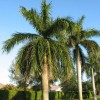 The royal palm is a large majestic palm that is native to south Florida and Cuba. It is considered cold hardy to about 28°F or USDA Cold Hardiness Zone 10A. This species quickly grows to heights of 50–70 ft., with a spread of 20–25 ft., and has a smooth light gray trunk up to 2 ft. in diameter. It is ideal for landscaping streets, parks, and commercial properties, but becomes too large for typical residential landscapes. This 4-page fact sheet was written by T.K. Broschat, and published by the UF Department of Environmental Horticulture, February 2014.
The royal palm is a large majestic palm that is native to south Florida and Cuba. It is considered cold hardy to about 28°F or USDA Cold Hardiness Zone 10A. This species quickly grows to heights of 50–70 ft., with a spread of 20–25 ft., and has a smooth light gray trunk up to 2 ft. in diameter. It is ideal for landscaping streets, parks, and commercial properties, but becomes too large for typical residential landscapes. This 4-page fact sheet was written by T.K. Broschat, and published by the UF Department of Environmental Horticulture, February 2014.
http://edis.ifas.ufl.edu/st574
Livistona chinensis: Chinese Fan Palm
 The Chinese fan palm is relatively slow growing, typically reaching about 30 feet in height. Its fan-shaped, costapalmate leaves can be 3 to 4 feet across and up to 6 feet long. Petioles of juvenile palms are spiny, but have few or no spines in adult palms. Because of its gracefully drooping leaf segment tips, this species is sometimes called the “fountain palm”. Young specimens are slow to form a trunk, which has led to the unfortunate practice of planting these palms close together as a ground cover. Eventually, most of those closely planted palms will have to be removed to accommodate their 10 to 12 foot spread. This 5-page fact sheet was written by Timothy K. Broschat, and published by the UF Department of Environmental Horticulture, April 2014.
The Chinese fan palm is relatively slow growing, typically reaching about 30 feet in height. Its fan-shaped, costapalmate leaves can be 3 to 4 feet across and up to 6 feet long. Petioles of juvenile palms are spiny, but have few or no spines in adult palms. Because of its gracefully drooping leaf segment tips, this species is sometimes called the “fountain palm”. Young specimens are slow to form a trunk, which has led to the unfortunate practice of planting these palms close together as a ground cover. Eventually, most of those closely planted palms will have to be removed to accommodate their 10 to 12 foot spread. This 5-page fact sheet was written by Timothy K. Broschat, and published by the UF Department of Environmental Horticulture, April 2014.
http://edis.ifas.ufl.edu/st365
Washingtonia robusta: Mexican Fan Palm
 The Mexican fan palm is a fast-growing species that can reach heights of 70 to 100 feet, making it too tall for typical residential landscapes. It is native to northern Mexico but grows well in Florida, being hardy down to about 20°F or USDA hardiness zone 9A. Mexican fan palms grow well in a wide range of soils in Florida, but do require good drainage. Though considered a desert palm, it is native to areas having permanent surface or subsurface water and thus is not as drought tolerant as might be expected. This 5-page fact sheet was written by Timothy K. Broschat, and published by the UF Department of Environmental Horticulture, February 2013.
The Mexican fan palm is a fast-growing species that can reach heights of 70 to 100 feet, making it too tall for typical residential landscapes. It is native to northern Mexico but grows well in Florida, being hardy down to about 20°F or USDA hardiness zone 9A. Mexican fan palms grow well in a wide range of soils in Florida, but do require good drainage. Though considered a desert palm, it is native to areas having permanent surface or subsurface water and thus is not as drought tolerant as might be expected. This 5-page fact sheet was written by Timothy K. Broschat, and published by the UF Department of Environmental Horticulture, February 2013.
http://edis.ifas.ufl.edu/st670
Syagrus romanzoffiana: Queen Palm
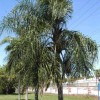 The queen palm is a popular feather-leaved palm with graceful arching leaves. It is one of the hardiest of the tropical-looking palms, being suitable for planting in USDA plant hardiness zone 9B (>25°F). Queen palms are considered to be moderately tolerant of salt spray. This 5-page fact sheet was written by Timothy K. Broschat, and published by the UF Department of Environmental Horticulture, October 2013.
The queen palm is a popular feather-leaved palm with graceful arching leaves. It is one of the hardiest of the tropical-looking palms, being suitable for planting in USDA plant hardiness zone 9B (>25°F). Queen palms are considered to be moderately tolerant of salt spray. This 5-page fact sheet was written by Timothy K. Broschat, and published by the UF Department of Environmental Horticulture, October 2013.
http://edis.ifas.ufl.edu/st609
Phoenix canariensis: Canary Island Date Palm
 The Canary Island date palm is native to the Canary Islands. Although it can reach heights of 40–50 feet, it is slow growing and requires many years to attain that height. It has 8- to 15-foot-long rigid leaves that contain up to 200 V-shaped leaflets, the basal ones of which are modified into long, sharp spines. Leaves are not self-cleaning and must be manually removed when dead, but the leaf bases eventually rot off, leaving an attractive diamond-shaped pattern of leaf scars on the 2- to 3-foot-diameter trunk. On older specimens, the basal foot or so of the trunk typically is covered with short root initials. This 6-page fact sheet was written by T. K. Broschat, and published by the UF Department of Environmental Horticulture, August 2013.
The Canary Island date palm is native to the Canary Islands. Although it can reach heights of 40–50 feet, it is slow growing and requires many years to attain that height. It has 8- to 15-foot-long rigid leaves that contain up to 200 V-shaped leaflets, the basal ones of which are modified into long, sharp spines. Leaves are not self-cleaning and must be manually removed when dead, but the leaf bases eventually rot off, leaving an attractive diamond-shaped pattern of leaf scars on the 2- to 3-foot-diameter trunk. On older specimens, the basal foot or so of the trunk typically is covered with short root initials. This 6-page fact sheet was written by T. K. Broschat, and published by the UF Department of Environmental Horticulture, August 2013.
http://edis.ifas.ufl.edu/st439
Sabal palmetto: Sabal or Cabbage Palm
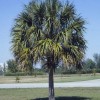 The sabal palm, or cabbage palm, is native to Florida and coastal regions of North and South Carolina and Georgia, and is the state tree of both South Carolina and Florida. The name “cabbage palm” comes from its edible immature leaves, or “heart,” which has a cabbage-like flavor. This 5-page fact sheet was written by T. K. Broschat, and published by the UF Department of Environmental Horticulture, July 2013.
The sabal palm, or cabbage palm, is native to Florida and coastal regions of North and South Carolina and Georgia, and is the state tree of both South Carolina and Florida. The name “cabbage palm” comes from its edible immature leaves, or “heart,” which has a cabbage-like flavor. This 5-page fact sheet was written by T. K. Broschat, and published by the UF Department of Environmental Horticulture, July 2013.
http://edis.ifas.ufl.edu/st575
Palm Morphology and Anatomy
 Palms differ greatly from broadleaf (dicot) and coniferous (Gymnosperm) trees in their overall form and external structure (morphology) and in their internal structure (anatomy). Morphology and anatomy determine how palms grow, function, and respond to external and internal stress factors. This publication provides a basic understanding of how palms are constructed. This 4-page fact sheet was written by T. K. Broschat, and published by the UF Department of Environmental Horticulture, May2013.
Palms differ greatly from broadleaf (dicot) and coniferous (Gymnosperm) trees in their overall form and external structure (morphology) and in their internal structure (anatomy). Morphology and anatomy determine how palms grow, function, and respond to external and internal stress factors. This publication provides a basic understanding of how palms are constructed. This 4-page fact sheet was written by T. K. Broschat, and published by the UF Department of Environmental Horticulture, May2013.
http://edis.ifas.ufl.edu/ep473
Field Production of Palms (ENH1210/EP471)
 Field production is the most practical means of producing large palm specimens, and it has several advantages over container production. Yield per acre can be maximized compared to many other woody ornamentals because of the columnar growth habit of most palms and their ability to survive transplanting with a minimal root ball. When dug and tied properly, many more palms can be loaded into a standard shipping container than could similarly sized trees. Palms also offer great versatility in the method of field harvesting.This 7-page fact sheet was written by Timothy K. Broschat, Alan W. Meerow, and Jack Miller, and published by the UF Department of Environmental Horticulture, April 2013.
Field production is the most practical means of producing large palm specimens, and it has several advantages over container production. Yield per acre can be maximized compared to many other woody ornamentals because of the columnar growth habit of most palms and their ability to survive transplanting with a minimal root ball. When dug and tied properly, many more palms can be loaded into a standard shipping container than could similarly sized trees. Palms also offer great versatility in the method of field harvesting.This 7-page fact sheet was written by Timothy K. Broschat, Alan W. Meerow, and Jack Miller, and published by the UF Department of Environmental Horticulture, April 2013.
http://edis.ifas.ufl.edu/ep471
Ornamental Palms for Central Florida (ENH60/EP020)
 Palms are often thought of as symbols of the tropics, but fortunately there are a number of palm species that grow in warm, temperate climates, such as that of Central Florida. This 8-page fact sheet was written by Timothy K. Broschat and James E. Davis, and published by the UF Department of Environmental Horticulture, January 2013.
Palms are often thought of as symbols of the tropics, but fortunately there are a number of palm species that grow in warm, temperate climates, such as that of Central Florida. This 8-page fact sheet was written by Timothy K. Broschat and James E. Davis, and published by the UF Department of Environmental Horticulture, January 2013.
http://edis.ifas.ufl.edu/ep020

